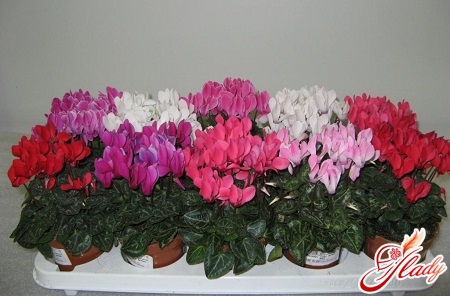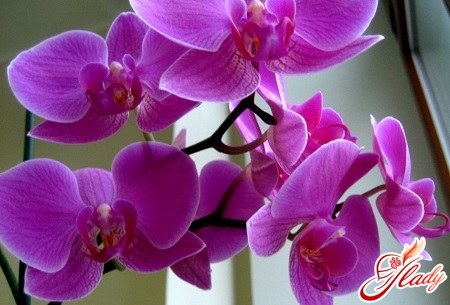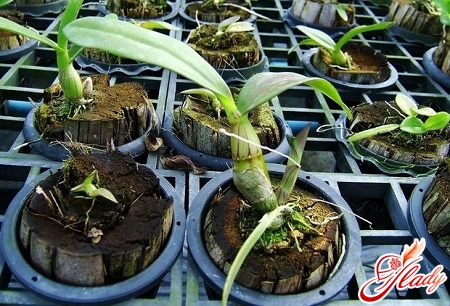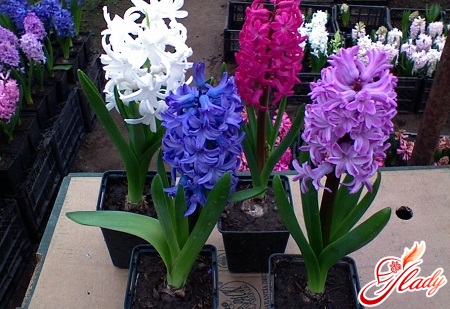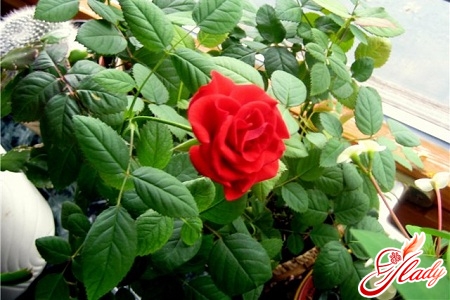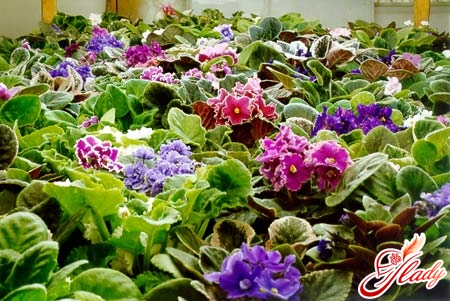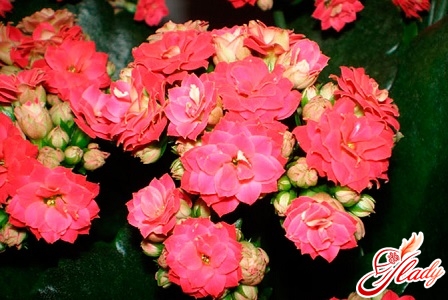 There is a belief that home Kalanchoebrings good luck. Most likely, this opinion is connected with the beneficial properties of this plant. After all, Kalanchoe juice is used not only in medicine, but also in cosmetology. Moreover, it has been used for a long time and quite successfully. In addition, this flower is amazingly beautiful, and caring for it is not difficult even for a novice gardener. Kalanchoe belongs to the family of Crassulaceae plants. Its species are quite diverse: on sale you can find both miniature specimens (growing only 30 centimeters), and quite large flowers (up to 1.5 meters). Kalanchoe blooms more often in winter, but there are species that throw out buds twice a year. The duration of flowering varies: from 2 weeks to several months. The homeland of Kalanchoe is considered to be South Africa, or to be more precise, the island of Madagascar. It is in these regions that this plant is found everywhere. Kalanchoe grows quite quickly: if you create all the necessary conditions for it, then in a couple of months a small stalk stretches out to 30-40 centimeters. When choosing a Kalanchoe, it is best to give preference to a plant with just opening buds and fleshy, “juicy” leaves.
There is a belief that home Kalanchoebrings good luck. Most likely, this opinion is connected with the beneficial properties of this plant. After all, Kalanchoe juice is used not only in medicine, but also in cosmetology. Moreover, it has been used for a long time and quite successfully. In addition, this flower is amazingly beautiful, and caring for it is not difficult even for a novice gardener. Kalanchoe belongs to the family of Crassulaceae plants. Its species are quite diverse: on sale you can find both miniature specimens (growing only 30 centimeters), and quite large flowers (up to 1.5 meters). Kalanchoe blooms more often in winter, but there are species that throw out buds twice a year. The duration of flowering varies: from 2 weeks to several months. The homeland of Kalanchoe is considered to be South Africa, or to be more precise, the island of Madagascar. It is in these regions that this plant is found everywhere. Kalanchoe grows quite quickly: if you create all the necessary conditions for it, then in a couple of months a small stalk stretches out to 30-40 centimeters. When choosing a Kalanchoe, it is best to give preference to a plant with just opening buds and fleshy, “juicy” leaves.
Types of Kalanchoe
There are about 200 species of Kalanchoe in the genus. Let's look at the most popular of them.
- Kalanchoe of Blossfeld
It is considered one of the most beautiful varieties.Kalanchoe. A miniature indoor shrub reaching 45 centimeters in height. It has smooth dark green leaves. The edges of the leaves have a wavy shape. It throws out many tubular inflorescences-umbrellas. The color of Kalanchoe flowers is varied: yellow, pink, red, orange;
- Kalanchoe Kalandiva
Created artificially, the progenitor was a speciesBlossfeld. Unlike the above-described variety, it has shorter flower stalks and is distinguished by abundant and long (up to six months) flowering. The color of the buds of this type of Kalanchoe can be different: from white to bright red;
- Kalanchoe Mangina
The peculiarity of this species is in the shape of its inflorescences. They look like miniature bells. Kalanchoe Mangina grows as a small bush, reaching a height of no more than 15 centimeters;
- Kalanchoe Degremona
Ornamental foliage indoor species.It has a straight stem and gray-green triangular leaves that grow up to 10 centimeters long. The edges of the leaves are jagged, and separate buds (babies) form between the teeth, which eventually fall off and immediately take root in the soil. It does not bloom.
- Kalanchoe pinnate
This species is considered the most hardy.It can reach 1.5 meters in height. It has light green serrated leaves and blooms with large bells. The color of the Kalanchoe flower is quite interesting: white turns into greenish, and then into pink. It reproduces in the same way as Degremona - by throwing babies into the ground. Kalanchoe pinnate is most often used for medicinal purposes - it is its juice that is sold in pharmacies.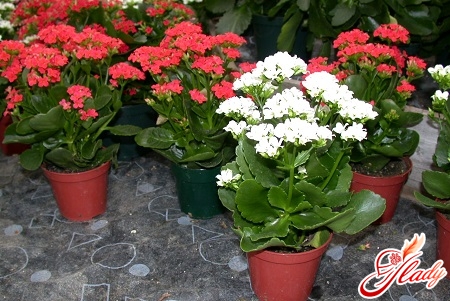
Cultivation at home
Lighting Successful cultivation of Kalanchoe inмногом зависит от освещения. Запомните – это растение любит солнце и зимой, и летом, поэтому лучше всего поместить его в светлом месте. Каланхоэ не боится прямых солнечных лучей, однако в полуденные часы желательно прикрывать его от летнего зноя. Особенно, если растение «живет» на южном окне. В теплое время года цветок отлично будет себя чувствовать на открытом воздухе: на балконе или веранде. Зимой каланхоэ нуждается в умеренной температуре воздуха: 12-15 градусов. Когда продолжительность светового дня уменьшается, желательно организовать для каланхоэ дополнительное искусственное освещение (утром и вечером) с помощью люминесцентных ламп. Особенно это важно в период цветения: при недостатке солнца листья растения приобретают бледность, а сами бутоны могут опасть, так и не успев раскрыться. Полив и подкормка Весной и летом каланхоэ необходим регулярный полив. Следите за состоянием грунта – как только верхний слой просохнет, устраивайте цветку водные процедуры. Подкормка осуществляется каждые 8-10 дней, используются специальные минеральные удобрения. Здесь подойдут подкормки, разработанные для кактусов или суккулентов. С наступлением осени полив и подкормки каланхоэ постепенно уменьшают. Зимой растение совсем не нуждается в удобрении, а вот полив следует производить раз в две недели (когда земляной ком просохнет полностью). Каланхоэ хорошо переносит сухость воздуха, однако периодическое опрыскивание ему не повредит. Для опрыскивания, как и для полива, используют только отстоянную воду комнатной температуры. Пересадка Осуществляется исключительно весной (апрель-май). Молодые каланхоэ пересаживают ежегодно. Посуда подбирается на размер больше предыдущей. Взрослые цветы нуждаются в «переселении» лишь в случае замены грунта (раз в 2-3 года). При пересадке обязательно используется дренаж — толщина слоя не менее 2-х сантиметров. Грунт для каланхоэ должен быть слабокислым либо нейтральным (pH 5.5-6.5) и состоять из песка, перегноя, дерновой и листовой земли. Для взрослых растений можно использовать покупную почвосмесь, предназначенную для суккулентов. Для молодых цветов желательно приготовить субстрат самостоятельно: 4 части дерновой земли, 2 части лиственной и по одной части песка и перегнившего торфа. Для лучшего роста в смесь добавляют коровий навоз и роговые стружки. Размножение Цветущие каланхоэ размножаются несколькими способами. Даже старые опавшие листья можно попробовать укоренить — в некоторых случаях процедура проходит довольно успешно. Если такой листок посадить в грунт и накрыть стеклянной банкой, через пару недель он уже пустит корешки и начнет развиваться. Для быстрого укоренения можно использовать специальный порошок – корневин. Данный способ подходит и для размножения черенками. Семена каланхоэ высаживают в середине зимы, для этого используют легкий лиственный субстрат. Семена помещают на слой почвы, сверху слегка присыпают и накрывают стеклом, затем бумагой. В помещении, где будут «жить» молодые растения, температура воздуха не должна превышать 18 градусов. Посевы необходимо проветривать два раза в сутки: утром и вечером. Для полива саженцев каланхоэ используют воду комнатной температуры (лучше дождевую или талую). Как только появятся всходы, стекло и бумагу убирают. Примерно в начале мая у саженцев уже будет по нескольку листочков. В это время их необходимо пересадить в семисантиметровые горшочки, по 3-4 штуки в каждый. В июле, когда растения хорошо укоренятся, верхушки прищипывают для создания красивой формы. На постоянное место жительства молодые каланхоэ «переезжают» в августе. Горшки подбираются по размерам цветка. В следующем году (в это же время) можно ждать первого цветения. 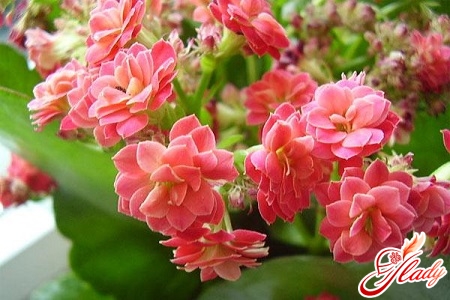
Pests and diseases
The Kalanchoe plant is resistant to diseases andpests. Usually it suffers from a lack of light (in summer) - the plant stretches too much, the leaves become pale and transparent. And from excessive heat (in winter) - the leaves of Kalanchoe dry out and fall off. With excessive watering and humidity, brown spots or mold appear on the stems and leaves. The most dangerous pests for Kalanchoe are mealybugs, spider mites and scale insects. To combat them, special products are used that can be purchased at a flower shop. It is quite easy to recognize pests. Mealybugs and scale insects leave behind whitish stripes and dots, both on the stems and on the buds. Spider mites literally suck the life out of Kalanchoe: the leaves begin to dry out, and a thin, barely noticeable web can be seen around the crown and on the flowers. If you notice that after abundant flowering, the Kalanchoe has become bare and stretched out, do not be upset - this is not a disease. Regular pruning will help here: shorten the stems and root them in the same pot. So we have considered the features of growing this useful and beautiful flower. Now the choice is yours! But remember, having purchased a houseplant, even such an unpretentious one as Kalanchoe, do not forget about it! After all, without proper care, you will never enjoy its flowering. We advise you to read:




